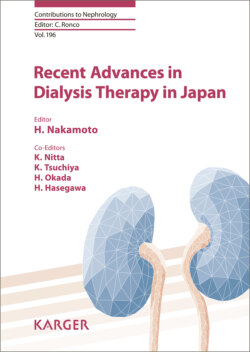Читать книгу Recent Advances in Dialysis Therapy in Japan - Группа авторов - Страница 102
На сайте Литреса книга снята с продажи.
Discussion
ОглавлениеThe pathogenesis of CKD is traditionally viewed from the perspective of the PTH-vitamin D axis, and current treatments focus on suppressing PTH with VDRA. Cross-sectional studies have shown, however, that FGF23 concentration is an early marker of CKD [11]. FGF23 concentration was found to positively correlate with PTH and P concentrations and negatively correlate with 1,25(OH)2D concentration, estimated glomerular filtration rate, and tubular phosphate reabsorption. It remains unclear whether FGF23 is directly toxic or is a biomarker for the harmful effects of phosphate metabolism and/or vitamin D deficiency.
All patients in our study who received i.v. VDRA were treated with maxacalcitol. Compared with other VDRAs, maxacalcitol is less likely to increase serum Ca levels, as its half-life is shorter (about 100 min) than the half-lives of other VDRAs, e.g. alfacalcidol (17.6 h) and calcitriol (11.4 h).
Administration of VDRA in an animal model was found to stimulate FGF23 production, resulting in higher FGF23 levels [19]. We have previously reported that calcitriol increases the expression of FGF23 in vitro in bone-derived cell cultures [20]. Previous studies in humans have assessed the relationship between i.v. VDRA therapy and serum FGF23 concentrations, and alfacalcidol and paricalcitol were reported to increase the plasma concentrations of FGF23 in hemodialysis patients [21, 22].
Table 3. Univariate and multivariate correlations between fibroblast growth factor 23 and other factors in hemodialysis patients
To our knowledge, this study is the first to investigate the correlation between i.v. maxacalcitol treatment and serum FGF23 levels in hemodialysis patients. The amount of serum FGF23 concentrations had increased to the amount of i.v. maxacalcitol per week dependency. Multivariate regression analysis showed that i.v. maxacalcitol was an independent predictor of serum FGF23 concentration, along with serum P and Ca concentrations. These effects may seem undesirable and may conflict with the benefits of VDRA therapy described in observational studies.
The use of VDRA therapy was shown to be an independent predictor of a lower risk of all-cause mortality and CVD mortality in hemodialysis patients [23, 24]. However, FGF23 has recently emerged as a powerful predictor of adverse outcomes in patients with CKD and ESRD. These findings present a paradox. We are conducting further research in an attempt to clarify this paradox.
This study had several limitations. First, this study is cross-sectional. So, we cannot exclude the possibility of bias or confounding. It is unclear whether the difference in FGF23 levels was due to a direct effect of maxacalcitol or selection bias; it is possible that those treated with maxacalcitol had more severe secondary hyperparathyroidism, which can lead to elevations in FGF23. Second, this study did not assess dietary phosphate load.
